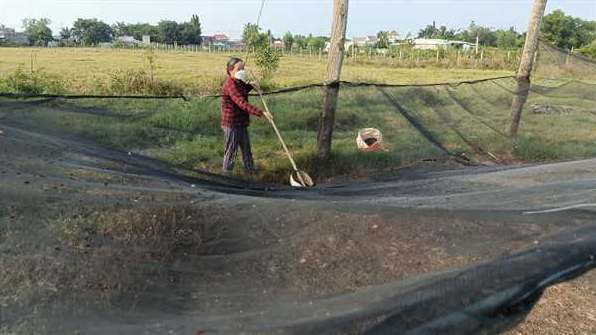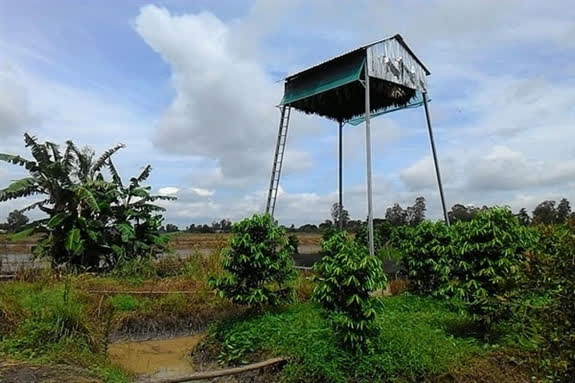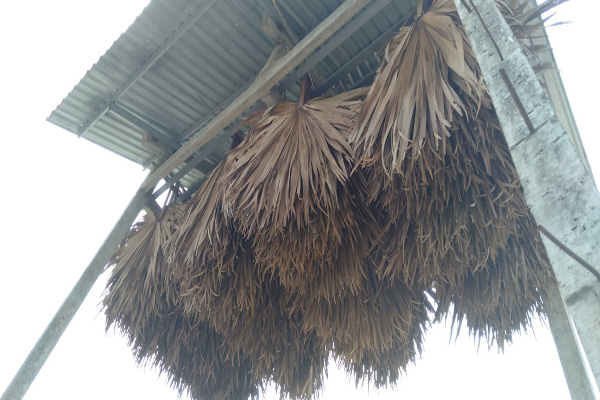Huong Son orange season
HA TINH – At the beginning of the 12th lunar month, people in Huong Son district start harvesting oranges,
The cool afternoon is also the time when Ms. Huong (An Hiep hamlet, An Thanh 3 commune, Cu Lao Dung district (Soc Trang)) starts harvesting bat droppings.
On the cement floor over 24m² wide, bat droppings are spread evenly on the surface of the freight nets. In just a few moments, Ms. Huong gathered them neatly, put them in a bag, and prepared for the second sale of the month.
Every day, Ms. Huong harvests more than 3kg of bat droppings and delivers them to termites once every 2 weeks. The price of bat droppings ranges from 60,000 to 80,000 VND/kg. On average, Huong earns about 7 million VND per month.($1=24,000 VND)
About 10 years ago, Huong’s family’s life was very difficult, income from a common land growing sugarcane and vegetables, working as a hired laborer was only temporary enough to cover living expenses.
Seeing that in the area, there are people raising bats to collect manure effectively, she discussed with her husband to set up a test cage. Due to a lack of capital, the bat cages only built tree columns, roofs with leaves, and temporary cement floors.
From the experience of raising bats learned, she and her husband bought jaggery leaves and brought them to soak in water to kill ant larvae, then dried, clustered, hung along the length of the barn, and lured the bats back. .
“Luckily for us, not long after setting up the barn, the bats came back to live and reproduce, the number is increasing. Thanks to the bats, in just over a year, my family’s economy has improved significantly. With enough money, I rebuilt the barn, built a sturdy cement pole, and the income from selling bat droppings has been steady since then “- Ms. Huong shared.
To save costs, Ms. Huong takes advantage of the vacant land around her house and grows jaggery trees herself. Currently, in addition to income from bat cages at home, Huong’s husband also goes to many places to collect bat droppings to get rid of termites.
According to Huong’s bat farming experience, raising bats is quite profitable, without having to spend money on food because they eat fruits and insects in the wild.
The “ideal” house for bats is to be secluded, airy, and quiet. This animal likes to be clean, so it has to work hard to clean the cage, every 5 days, the old leaves are washed, dried, and replaced.
After 5-6 months, all leaves must be replaced, however, new leaves must be mixed with a few old leaves so that the bats will not be in strange places, because if they move to the nest if there are unusual signs, the bat will leave. The change of leaves must also be done quickly before the bats return.
In addition, in the rainy season, you have to work hard to cover and keep the bats warm, to prevent the bats from getting wet, and in the hot season, reduce leaves to keep the barn cool.
Breeders must regularly observe the nest to eliminate snakes, scorpions, and owls that harm the bats. The best time to harvest bat droppings is in the rainy season, because the food source of bats is abundant, on average, bats will give feces from 7 to 8 kg/day…
Realizing that the model of raising bats for manure is effective, Ms. Huong showed a way for relatives and acquaintances to build cages and attract bats to nest. Currently, many people rely on raising bats for manure, thanks to the high price of bat dung, they overcome difficulties and escape poverty. Some people have a monthly income twice as much as Huong’s family, becoming well off.
Chairwoman of the Women’s Union of An Thanh 3 commune, Cu Lao Dung district, (Ca Mau province) Tran Thi Thom said that in the commune, there are about 5-6 households raising bats for feces, in which, her family Cam Huong effectively raised and maintained a stable herd of bats.
The model of bat farming is encouraged locally, because bats not only bring economic benefits to people, but also limit infectious diseases caused by mosquitoes, reduce other harmful insects, and contribute to protection. trees, crops. According to.
According to engineer Le Van Khoa (Agricultural Extension Station of Chau Thanh District, Kien Giang), to attract bats to live in, we catch about 10 bait bats and put them in 2-3 net cages hung on the bat cage so that the bait bats can make noise. call the herd to come back. If the bat does not return, then about 2 days later we release the old bait bat, find another new bait bat to replace it until the bat comes back, then stop.
Currently, bat droppings cost from 60,000-80,000 VND/kg. If you make about 3 huts to raise bats and raise 90,000 bats, every day bat farmers can harvest about 20-30kg of bat droppings. Thus, a year, farmers can earn more than 500 million VND from selling bat droppings.
Or like in Phung Hiep (Hau Giang), the bat farming model here is also quite simple.
The bat cages are made by people here with an area of about 60m2, about 8-10m high, with a corrugated iron roof, under the roof hang about 1,000 jaggery leaves that are assembled into arrays to make a place for bats to hide. The cost of making a bat cage is less than 30 million VND, used for many years.
Mr. Nguyen Van Chot, who has more than 10 years of raising bats for feces, in Binh Thanh commune, said: Bats raised for feces are mosquito bats, specializing in eating insects in the field, so the excrement is very good for plants. plant. His family’s two bat cages earn over 2 bushels of manure per day, traders go to their homes to buy them for over 300,000 VND/ bushel. On average, his family earns over 70 million VND per year.
According to Chau Thanh Agricultural Extension Station, bat farming techniques can be implemented as follows:
1. Characteristics of bats
The bats raised here are mosquito bats, creatures living in nature, each weighing a few tens of grams. As its name suggests, this type of bat only eats mosquitoes, butterflies, planthoppers and does not damage farmers’ fruit trees. Bats are active at night and in the morning find a quiet place to sleep. And during this time, bats excrete the previous day’s food into feces.
Bats usually go to eat around 18:00 – 18:30, when the sky is clear. If it rains, bats stay in their cages and fly out to eat when the weather clears. If the area where bats live with little bait, the bats go hunting very far, sometimes more than 10 km, and don’t return until about 5 am. Knowing the above characteristics, people make cages to raise bats for feces.
2. Techniques for making bat cages
Choose a place to make a cage for bats so that it is quiet and discreet, especially with low trees, low noise… the cage must be placed on the banks of canals and ditches for the bats to drink water.
The barn must be tall, cool in the summer, warm in the winter, and always clean. How to keep the temperature in the stable at 30-32 degrees Celsius is the best.
The size of the barn is 5m wide, 7-9m long. Build 4 cement columns with a height of 6 m, the roof of the barn is 1.5 m high. You can also build a barn with columns of melaleuca trees.
According to the experience of many successful breeders, the barn is roofed with bat leaves more than the tol roof. Roofing leaves must be shredded water coconut leaves for longer use time. The roof is carefully lifted to prevent the wind from blowing the roof, and the wet rain makes the bats have to leave the cage to another place.
The floor of the barn : Can be coated with cement or spread net. Bat droppings will be swept and collected.
The medium for bat shelter is palm leaves. With the size of the barn as above, it is possible to use 300-400 palm leaves.
Choose dry but new leaves, not rotting, when cut, they must be soaked in water before drying to kill ant larvae that are enemies of bats.
Every 3-5 days, you have to climb up to replace the leaves contaminated with bat droppings and every 4-5 months you have to change all the leaves.
How to hang leaves as a shelter for bats: Under the roof of the barn, we hang trees along the length of the cage, each tree is about 4-5 inches apart to hang leaves as a shelter for bats.
Cut the petiole leaving about 3-5 inches, then punch the petiole holes, connect the 5 leaf stalks into a bunch with wire broken into hooks and hang them on the plants that are released along the length of the barn.
3. How to attract bats to raise:
To attract bats to stay, we catch about 10 bait bats and put them in 2-3 net cages hanging on the cage so that the bait bats make a call to lure the flock back. If the bat does not return, then about 2 days later we release the old bait bat, find another new bait bat to replace it until the bat comes back, then stop.
4. Care
Bats are wild animals, fastidious, like to live freely, very sensitive to strangers, as well as animals and insects capable of harming them, if they move they will leave. Therefore, farmers must know how to encourage and protect them, not to catch them in cages.
Dangerous enemies for bats are snakes, pigs, aphids and ants, so we often clear bushes, hunt birds and pigs… to limit enemies from invading bats.
Because bats excrement can contaminate palm leaves, every 3-5 days we have to bring down the old bunches of leaves to wash, dry and replace with new ones. Change the leaves when the bats come out of the cage to eat around 6 pm and change quickly in about 15 minutes. If you don’t change it in time, change it about 1/3, and then change it again, because if you meet a stranger, the bat will leave the cage.
5. Harvesting bat droppings: Under the bat cage, we have a net to collect bat droppings every day, if not harvested early, the ants will release the droppings, and if it rains, the manure will flow out.
Photo: Internet (vinlove.net)




